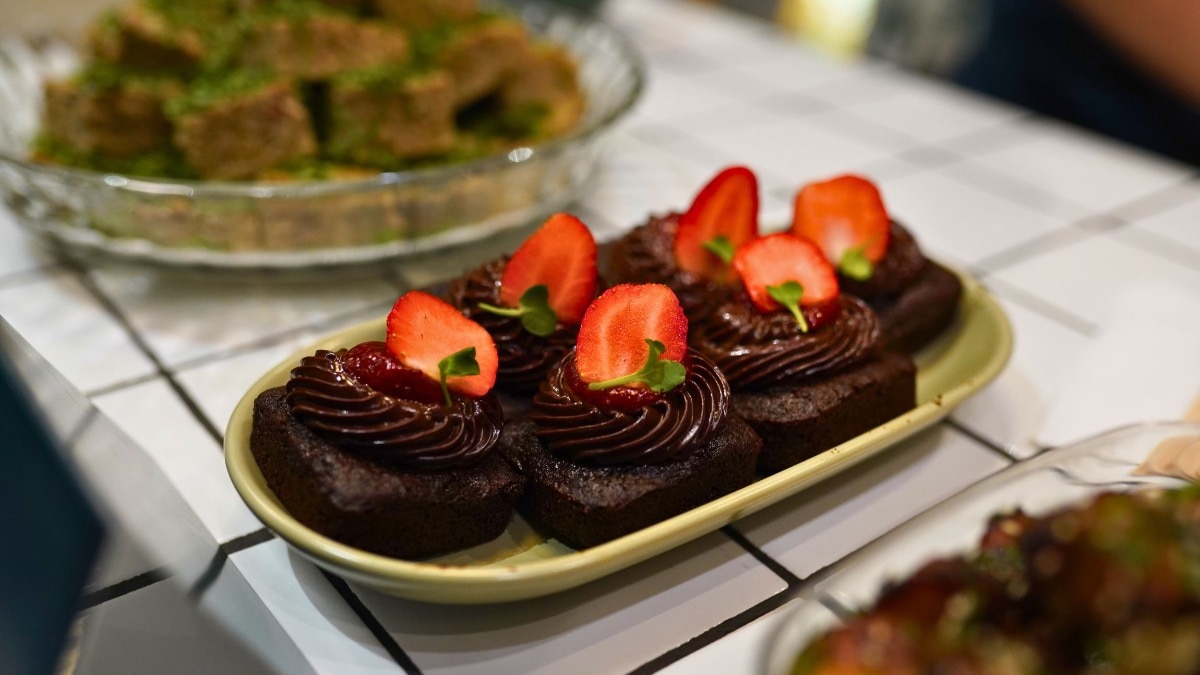How mapo tofu became the fiery global star of Sichuan cuisine
Mapping the journey of the Chinese dish from the by-lanes of Chengdu to restaurants all over the world.


Mention tofu and the first thing that comes to mind for most of us is the dry, crumbly soybean block from the supermarket that passes of as a sad vegan substitute for paneer. We’ve tried deep frying it, dousing it in a spread of sauces, or hiding it behind batter in pakodas. It’s difficult to make it palatable. The hard truth is that all this while we’ve been eating the wrong kind, and making it the wrong way.
Meet the hot and umami mapo tofu
Deeply savoury, funky, and rich. Those three words sum up mapo tofu perfectly—it’s impossible not to like. Silky tofu, ground meat, and spices are cooked in a spicy red sauce that has a layer of oil floating on top and is finished with a generous sprinkle of scallions. The Chinese dish is traditionally made with minced beef, although many cooks now use pork or skip meat altogether. Indians will find the soft tofu and spicy sauce combo quite close to a dry paneer preparation (kadhai paneer comes to mind).
It’s a 160-year-old dish that is still going strong
Chef Fu-Lei, master chef at JW Mariott Pune’s new Chinese restaurant Tao-Fu, sheds some light on the unique history of mapo tofu. “It is a Sichuan dish from the North Chengdu province of China that goes back to 1862, during the Qing dynasty. There was a couple, Mr and Mrs Chen, who used to run a restaurant called Chen Xing Sheng”. According to The Michelin Guide, the century-old shop still exists today, and goes by the name Chen Mapo. The “ma” in mapo is for “crater face,” and the “po” stands for “old woman”. Mrs Chen's face was marked with smallpox scars, so she was given this nickname that means "pock-marked old woman". Fuschia Dunlop also traces the dish’s origin in her cookbook Every Grain of Rice—“Mapo tofu is one of the best-loved dishes of Chengdu. Mrs Chen delighted passing labourers with her hearty braised tofu, cooked up at her restaurant by the Bridge of 10,000 Blessings in the north of the city”. More than its rich heritage, it’s the fact that it has survived to date, in its authentic state, which makes it even more impressive.

The holy trinity of mapo tofu–Sichuan peppercorns, chilli oil, and doubanjiang
These three make up the flavor foundation on which the dish stands. Of course, the right kind of tofu is key too—Dunlop mentions that the ideal candidate is one that is extremely tender but will still holds its shape when cut into cubes. Soft tofu (not to be confused with silken) fits the bill perfectly. At Tao-Fu, chef Fu-Lei makes it from scratch in what is a labour-intensive two-day process. “Tofu is a versatile ingredient and seamlessly soaks up the flavor of the umami spicy sauce it’s prepared in," notes chef Raymond Wong, master chef-Asian at By the Mekong, The St. Regis Mumbai. Doubanjiang is undoubtedly the most important ingredient of mapo tofu—its spicy and umami depth is hard to substitute. Literally translating to spicy bean sauce, it is a Sichuan paste made from fermented soybeans, broad beans, and chillies. Sichuan peppercorn, which despite its name is not part of the peppercorn family, makes up the second pillar of the dish. It is the infamously hot Chinese spice that leaves a tingly, numbing sensation on your tongue. It is behind the quintessential flavor of Sichuan cuisine called mala, which means “spicy and numbing”. Chef Fu-Lei notes that you’ll also find this flavor profile in other Sichuan dishes like kung pao chicken and chilli chicken. In India, the peppercorn is known as timur in the Northeast and bears resemblance to the Marathi triphal, its relatively lesser-known cousin that has larger berries and the same tingling quality. Chilli oil adds another layer of heat and the synonymous red hue to mapo tofu. And the best one doesn’t come out of a bottle. “Although one can purchase bottled chilli oil at a grocery store, I highly recommend you make it at home for the perfect amount of heat, colour and texture," explains chef Wong.

The secret to a well-made mapo tofu is balance
When a dish is known for being tongue-numbingly spicy, it can quickly become overwhelming. But practicing restraint is essential. “The numbing heat can be balanced with the right amount of a slurry made with fermented bean paste and cornstarch dissolved in water with a pinch of palm sugar or less Sichuan chilli oil," says chef Wong. “…adding a bit of sugar balances it out perfectly," agrees chef Rohit Chadha, executive sous chef at JW Marriott Juhu.
Mapo tofu and rice—a match made in heaven
For chef Fu-Lei, nothing comes close to mapo tofu than a bowl of plain steamed rice. According to him, it balances the strong flavor of the dish. Chef Wong concurs, “Since mapo tofu is traditionally a spicy, strong-flavored dish, I would suggest eating it with steamed jasmine rice and a cold Chinese-style smashed cucumber salad with sesame.” Chef Chadha goes one step further by suggesting that one finishes with a scoop of ice cream to counteract the fiery mapo tofu.

Korea’s mapa dubu and Japan’s mabo dofu—same same but different
For a dish this loved, it would be impossible for it to not have different versions. Koreans make it as mapa dubu, where the staple doubanjiang is replaced by gochujang (fermented hot chilli paste), gochugaru (red chilli pepper flakes), and doenjang (fermented soybean paste). Apart from these changes, the dish remains faithful to the original. Japanese mabo dofu, on the other hand, is a milder take on mapo tofu and doesn’t have the signature Sichuan peppercorns that the Chinese one has. Instead, all the spiciness comes only from doubanjiang. The Japanese also do a non-tofu version called mabo nasu with eggplant. All these variations make mapo tofu the perfect poster-child of global cuisine.

Desi-fying the mapo tofu for an Indian palate
How does a dish with either pork or beef as one of its major ingredients fare in a country like India, where there’s still a notion that most of them don’t consume meat? Many Indian restaurants have gone the vegetarian, or vegan route. Chef Fu-Lei elaborates, “It was our decision to keep it vegetarian. The dish has so much heritage and we wanted everyone to taste and experience it, especially since not all Indians are very fond of beef and pork.” The restaurant does offer a pork version, if you want to try it out. Apart from this, and the fact that they’ve reduced the Sichuan peppercorns, the dish stays true to its origins. “Mapo tofu is a dish that is packed with bold flavors and fiery spices, and perfectly aligns with the Indian flavor palate. I have tweaked the recipe at Dashanzi to offer dairy-free and vegetarian variations to cater to our Indian guests who are predominantly vegetarian," says chef Chadha.
Going beyond the classic–mapo lasagna, anyone?
“It’s easy to create variations of mapo tofu as it’s such a versatile dish," says chef Wong. He recommends veganizing it with shiitake mushrooms, or doing a pescatarian variation with seafood. However, he advises against straying too far from the original. Chinese-American chef Lucas Sin from Hong Kong, who was Food & Wine’s Best New Chef ’21 and part of the Forbes 30 Under 30 class of ’20, would disagree. A quick look at his Instagram account and you’ll find fusions like mapo tofu lasagna and mapo beans with chickpeas instead of tofu. For him, it’s all about "fusion for fusion’s sake", and having fun with beloved dishes to create something new and exciting. Knowing the roots of the dish before you set out to tweak it is important though. “It will be best to learn (the authentic dish) first, before you try to alter, change or improve," says Stephanie Li, one-half of the husband-wife duo behind the popular YouTube channel Chinese Cooking Demystified, in their mapo tofu video.

Whatever the case may be, from the revered classic to outrageous (but delicious) combinations, the Sichuan dish that originated as a filling meal for the working class has today infiltrated menus at five-star restaurants, surpassed borders to rule the hearts of spice lovers all over the world, and yet has managed to (mostly) be it’s true self.
Lead image: Tao-Fu, JW Marriott Pune










